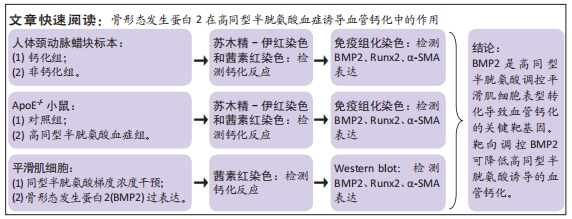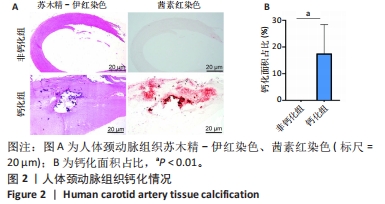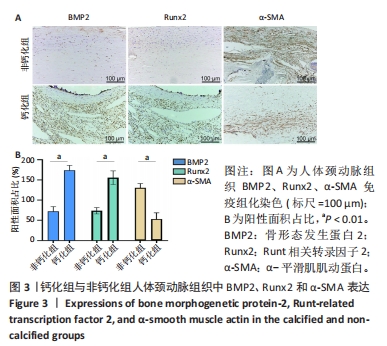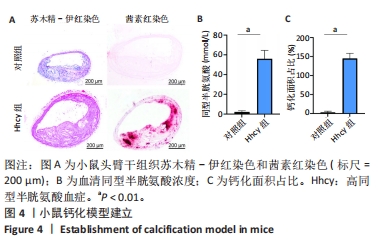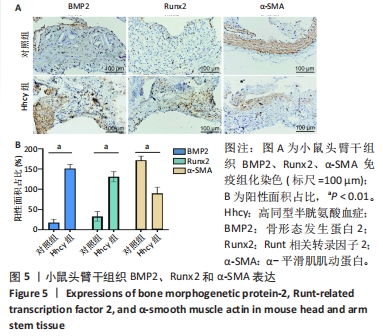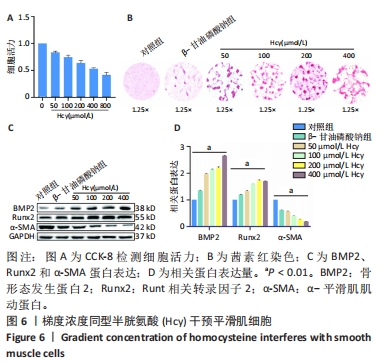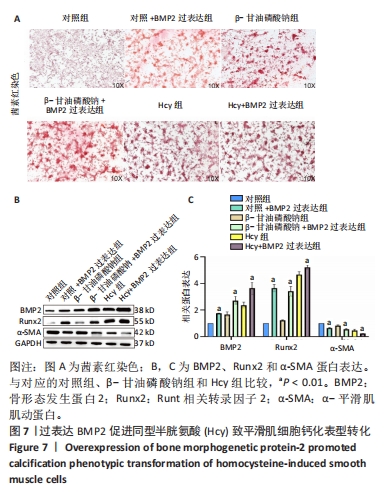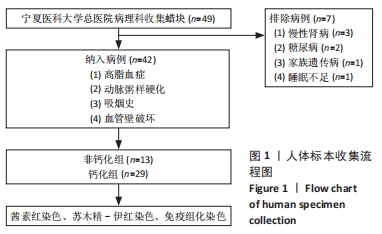[1] ALLISON MA, HSI S, WASSEL CL, et al. Calcified atherosclerosis in different vascular beds and the risk of mortality. Arterioscler Thromb Vasc Biol. 2012;32(1):140-146.
[2] LEE SJ, LEE IK, JEON JH. Vascular Calcification-New Insights Into Its Mechanism. Int J Mol Sci. 2020;21(8):2685.
[3] QUAGLINO D, BORALDI F, LOFARO FD. The biology of vascular calcification. Int Rev Cell Mol Biol. 2020;354:261-353.
[4] AZZINI E, RUGGERI S, POLITO A. Homocysteine: Its Possible Emerging Role in At-Risk Population Groups. Int J Mol Sci. 2020;21(4):1421.
[5] MORETTI R, CARUSO P. The Controversial Role of Homocysteine in Neurology: From Labs to Clinical Practice. Int J Mol Sci. 2019;20(1):231.
[6] RENNENBERG RJ, SCHURGERS LJ, KROON AA, et al. Arterial calcifications. J Cell Mol Med. 2010;14(9):2203-2210.
[7] YANG P, TRONCONE L, AUGUR ZM, et al. The role of bone morphogenetic protein signaling in vascular calcification. Bone. 2020; 141:115542.
[8] ZHU L, ZHANG N, YAN R, et al. Hyperhomocysteinemia induces vascular calcification by activating the transcription factor RUNX2 via Krüppel-like factor 4 up-regulation in mice. J Biol Chem. 2019;294(51):19465-19474.
[9] 代庆刚. mTOR/Raptor-S6K1信号通路通过Runx2调控小鼠成骨分化及骨发育[D].上海:上海交通大学,2016.
[10] 黄辉,张爱华,陈靖,等.血管钙化研究进展和临床实践的共识与争议[J].生理学报,2022,74(6):859-884.
[11] 蔡云峰.老年冠心病患者血清脂蛋白A-1、胱抑素C、同型半胱氨酸水平与冠状动脉粥样硬化的相关性分析[J].中国卫生检验杂志, 2023,33(4):479-481,486.
[12] VILLA-BELLOSTA R. Vascular Calcification: Key Roles of Phosphate and Pyrophosphate. Int J Mol Sci. 2021;22(24):13536.
[13] WILCKEN DE, WILCKEN B. The pathogenesis of coronary artery disease. A possible role for methionine metabolism. J Clin Invest. 1976;57(4): 1079-1082.
[14] 范驰,马珊珊,张薇,等.血清Hcy HbA1c及APN与急性脑梗死患者认知功能障碍的相关性分析[J].河北医学,2023,29(1):147-153.
[15] 李峰,王颖,王雪,等.应激与同型半胱氨酸诱导认知功能障碍作用机制的研究进展[J].军事医学,2022,46(11):867-871.
[16] 李娜,杨爽,林卫红.糖尿病肾病患者同型半胱氨酸水平与颈动脉粥样硬化关系的研究[J].中风与神经疾病杂志,2022,39(8):731-735.
[17] MUZUROVIĆ E, KRALJEVIĆ I, SOLAK M, et al. Homocysteine and diabetes: Role in macrovascular and microvascular complications. J Diabetes Complications. 2021;35(3):107834.
[18] XIE W, SHAN Y, WU Z, et al. Herpud1 deficiency alleviates homocysteine-induced aortic valve calcification. Cell Biol Toxicol. 2023. doi: 10.1007/s10565-023-09794-w.
[19] 梁英权,段亚君,韩际宏.血管钙化分子机制研究进展[J].中国动脉硬化杂志,2020,28(11):921-929.
[20] BROZOVICH FV, NICHOLSON CJ, DEGEN CV, et al. Mechanisms of Vascular Smooth Muscle Contraction and the Basis for Pharmacologic Treatment of Smooth Muscle Disorders. Pharmacol Rev. 2016;68(2): 476-532.
[21] HO CY, SHANAHAN CM. Medial Arterial Calcification: An Overlooked Player in Peripheral Arterial Disease. Arterioscler Thromb Vasc Biol. 2016;36(8):1475-1482.
[22] STANFORD W, THOMPSON BH. Imaging of coronary artery calcification. Its importance in assessing atherosclerotic disease. Radiol Clin North Am. 1999;37(2):257-272.
[23] KARMIN O, SIOW YL. Metabolic Imbalance of Homocysteine and Hydrogen Sulfide in Kidney Disease. Curr Med Chem. 2018;25(3): 367-377.
[24] 丁浩,曹娟.高磷诱导血管平滑肌细胞钙化的信号通路研究进展[J].中国中西医结合肾病杂志,2020,21(7):650-653.
[25] LANZER P, BOEHM M, SORRIBAS V, et al. Medial vascular calcification revisited: review and perspectives. Eur Heart J. 2014;35(23): 1515-1525.
[26] MA WQ, SUN XJ, ZHU Y, et al. Metformin attenuates hyperlipidaemia-associated vascular calcification through anti-ferroptotic effects. Free Radic Biol Med. 2021;165:229-242.
[27] YANG W, ZOU B, HOU Y, et al. Extracellular vesicles in vascular calcification. Clin Chim Acta. 2019;499:118-122.
[28] ZHANG F, LI J, GU C, et al. MiR-140-5p upregulation suppressed β-glycerophosphate-induced vascular smooth muscle cell calcification via targeting TLR4. Immunopharmacol Immunotoxicol. 2022;44(3): 295-305.
[29] TIAN L, WANG Y, ZHANG R. Galectin-3 induces vascular smooth muscle cells calcification via AMPK/TXNIP pathway. Aging (Albany NY). 2022;14(12):5086-5096.
[30] TAO Y, GENG Y, DANG W, et al. Mechanism of Endoplasmic Reticulum Stress Pathway in the Osteogenic Phenotypic Transformation of Aortic Valve Interstitial Cells. Front Endocrinol (Lausanne). 2022;13:856331.
[31] SULISTYOWATI E, HSU JH, LEE SJ, et al. Potential Actions of Baicalein for Preventing Vascular Calcification of Smooth Muscle Cells In Vitro and In Vivo. Int J Mol Sci. 2022;23(10):5673.
[32] SHI C, TAN J, LU J, et al. MicroRNA-17-5p Promotes Vascular Calcification by Targeting ANKH. Curr Neurovasc Res. 2022;19(1):108-116.
[33] JIANG Y, JI W, ZHU J, et al. Upregulation of miR-664a-3p Ameliorates Calcific Aortic Valve Disease by Inhibiting the BMP2 Signaling Pathway. Dis Markers. 2022;2022:2074356.
[34] HAO N, ZHOU Z, ZHANG F, et al. Interleukin-29 Accelerates Vascular Calcification via JAK2/STAT3/BMP2 Signaling. J Am Heart Assoc. 2023; 12(1):e027222.
[35] QIN CM, WEI X, GONG CP, et al. Expression of BMP2/Smad1/Runx2 Signal Pathway in Renal Artery of Rat with Vascular Calcification. Sichuan Da Xue Xue Bao Yi Xue Ban. 2016;47(2):180-183.
[36] CHEN Z, DING W, DUAN P, et al. HWJMSC-derived extracellular vesicles ameliorate IL-1β-induced chondrocyte injury through regulation of the BMP2/RUNX2 axis via up-regulation TFRC. Cell Signal. 2023;105:110604.
[37] LEE SH, KIM M, PARK MH. Diphlorethohydroxycamalol isolated from Ishige okamurae prevents H2O2-induced oxidative damage via BMP2/Runx2 signaling in osteoblastic MC3T3-E1 cells. Fitoterapia. 2021;152:104921.
[38] LIN Y, SUN Z. Klotho deficiency-induced arterial calcification involves osteoblastic transition of VSMCs and activation of BMP signaling. J Cell Physiol. 2022;237(1):720-729.
[39] LIN X, LI F, XU F, et al. Aberration methylation of miR-34b was involved in regulating vascular calcification by targeting Notch1. Aging (Albany NY). 2019;11(10):3182-3197.
[40] TANAKA U, KAJIOKA S, FINOTI LS, et al. Decitabine Inhibits Bone Resorption in Periodontitis by Upregulating Anti-Inflammatory Cytokines and Suppressing Osteoclastogenesis. Biomedicines. 2021; 9(2):199.
[41] CHEN R, QIU H, TONG Y, et al. MiRNA-19a-3p alleviates the progression of osteoporosis by targeting HDAC4 to promote the osteogenic differentiation of hMSCs. Biochem Biophys Res Commun. 2019;516(3):666-672.
|
